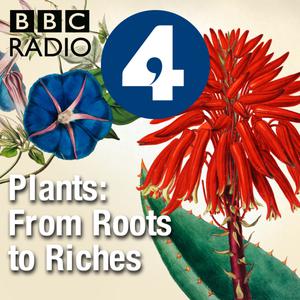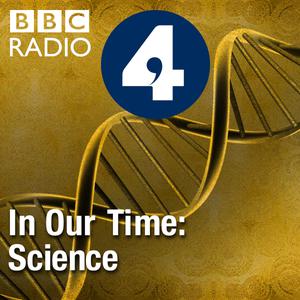
Plants: From Roots to Riches
BBC
Kathy Willis considers our changing relationship with plants over the last 250 years - from tools to exploit, to objects of beauty, to being an essential resource we must conserve.
- 56 minutes 42 secondsEpisode 5
Professor Kathy Willis, director of science at the Royal Botanic Gardens Kew, with the final episodes of her new history of our changing relationship with plants
Kathy Willis examines how the technology that helped map whole genomes in plants and animals was to revolutionise the classification of flowering plants; the evolution of our rainforests as revealed by DNA fingerprinting; plants as essential regulators of our planet's atmospheric carbon and water cycles; how green spaces and ecosystems have a positive effect on our health and well being; the future role of plants as providers of food to feed the planet's growing population.
Producer Adrian Washbourne.
18 November 2014, 4:32 pm - 56 minutes 57 secondsEpisode 4
Prof Kathy Willis, Director of Science at Royal Botanic Gardens Kew, with an omnibus edition of her history of our changing relationship with plants from the early 20th century.
She examines new insights into plant hormones during the first few decades of the 20th century, the manipulation of which underpinned the perceived success of the so called Green Revolution; unlocking biodiversity through the creation of plant flora encyclopaedias - and their influence in conservation; the surprising benefits to emerge from the devastation wreaked by the great storm of 1987; what can be gained by preserving the diversity of plants through seed banking; the legacy of Arabidopsis - the first plant to have its entire genome sequenced.
Producer Adrian Washbourne.
18 November 2014, 4:02 pm - 56 minutes 44 secondsEpisode 3
Prof Kathy Willis, Director of Science at the Royal Botanic Garden, Kew, with the omnibus edition of her history of our changing relationship with plants during the early 20th century.
Kathy Willis examines how the complete picture of photosynthesis led to new opportunities to manipulate plant growth; the ability of plants to exhibit multiple forms that shed light on why flowering plants evolved so quickly; the legacy of tree diseases during the 20th century; the hunt for wild ancestors of our domestic crops in order to maintain resilience within our future food supplies; and botanical medicines and the hunt for new medicinal cocktails at home and abroad.
Producer Adrian Washbourne.
18 November 2014, 3:46 pm - 57 minutesEpisode 2
Prof Kathy Willis, Director of Science at the Royal Botanic Garden, Kew, with the omnibus edition of her history of our changing relationship with plants during the 19th century.
She examines the race to tame and culture the prized Amazonian water lily which played out in glare of the nations' new greenhouses; the smuggling of rubber seeds out of Brazil to establish a rubber industry in the British colonies; how a growing passion for orchids opened a new episode in cultivating exotic plants for all; the threat posed by the rise of invasive species; and how a new precision in understanding the behaviour of hybrids led to the birth of modern genetics at the close of the 19th century.
Producer Adrian Washbourne.
18 November 2014, 3:31 pm - 56 minutes 49 secondsEpisode 1
The first of five omnibus editions of Prof Kathy Willis' timely new history of our changing relationship with plants
From the birth of modern plant classification, harnessing botany and imperial progress in furthering Britain's destiny as the major civilising power in the world , to establishing the laws of what grows where and why, Professor Kathy Willis, Director of Science at the Royal Botanic Gardens Kew, examines new attitudes to plants during the 18th and early 19th century.
From plants as tools to exploit to flowers as objects of beauty, Kathy Willis draws upon Kew's archives and its herbarium collection of pressed plants that was to play a pivotal role in establishing insights into plant relationships and their distribution around the world. It was to help establish the first accurate maps of the world's flora by the mid 19th century.
Producer: Adrian Washbourne
Presenter: KATHY WILLIS is director of science at Royal Botanic Gardens at Kew. She is also professor of long-term ecology and a fellow of Merton College, both at Oxford University. Winner of several awards, she has spent over 20 years researching and teaching biodiversity and conservation at Oxford and Cambridge.
18 November 2014, 1:45 pm - 14 minutes 1 secondThe Great Providers
Prof Kathy Willis concludes her major new history series by asking how much plant biodiversity is worth, and examines new research into securing the future of our staple crops.
Understanding the distribution, diversity and potential of plants for food, lay at the heart of the 18th century botanical impresario Joseph Banks' vision to "improve Britain's estates of the world". To secure future resilience of crops in today's world there's a growing need to conserve the closest wild relatives of our staple crops.
Kathy Willis discovers, given climatic threats to some of our most substantial crops such as coffee - for which the industry currently depends on a single species, the economic value of wild relatives of today's domestic crops is considerable.
And as we hear, some important future crops are still to be found from previously overlooked plants.
With contributions from Richard Thompson, Business valuations partner at Price-Waterhouse Cooper; historian Jim Endersby; head of coffee research at Kew, Aaron Davis; Kew's head of yams Paul Wilkin.
Producer Adrian Washbourne
Music for the series was composed by Mark Russell.
22 August 2014, 1:00 pm - 14 minutes 3 secondsGreen and Pleasant Lands
Prof. Kathy Willis examines the different kinds of spiritual, physical and intellectual links that we have with the landscape and their diverse ecosystems and the extent to which they contribute to our health and well being.
As well as providing a source of inspiration and recreation there's plenty of anecdotal evidence suggesting that green spaces can make a positive contribution to our health, but what kinds of landscapes are of greatest benefit?
Kathy Willis assesses the some of the latest research assessing physiological and psychological benefits that ecosystems can provide from manicured botanical gardens to wild open countryside
With contributions from Richard Barley, director of horticulture Kew Gardens; Rachel Bragg researcher in Green Care at Essex University, Shonil Bhagwat environmental geographer at the OU, and historian Jim Endersby
Producer Adrian Washbourne.
21 August 2014, 1:00 pm - 14 minutes 5 secondsCapture and Drawdown
In 2005 a landmark study was published which changed the political landscape for conservation, probably for ever. Rather than viewing biodiversity as something to be conserved for conservation's sake, the Millennium Ecosystem Assessment started to assess the contributions that biodiversity makes to human livelihoods and well-being. These include regulating services ( such as modulating climate), cultural services (the spiritual, educational and recreational value) and provisioning services (the biodiversity that provides food, fresh water, and fuel).
Professor Kathy Willis examines the first of these new approaches to biodiversity conservation by firstly assessing the role plants play in regulating our atmospheric carbon dioxide. She talks to Yadvinder Mahli on the importance of trees in drawing down and capturing carbon and on new understandings in where the effect is most apparent on our planet.
But how we view ecosystems at the landscape scale is equally important if plants are to flourish in this capacity and recent reduction in vital plant pollination services are proving to be poorly understood .
But as Kathy Willis hears from chemistry ecologist Phil Stevenson, one of several approaches in improving the memory of bees that account for 30% of plant pollination could have a dramatic and significant effect in securing this vital function.
Producer: Adrian Washbourne.
20 August 2014, 1:00 pm - 13 minutes 55 secondsDynamic Rainforest
Palms provide many basic necessities and are collectively one of the most important plants families after grasses and legumes. In 2007 and extraordinary new find came to light when a French plantation manager in Madagascar, came across a new species of palm tree 18metres high and with a 5m leaf span - visible from Google Earth. The palm family continues to grow at a rapid rate As new species make themselves known to science it's becoming vital to appreciate their potential uses. Discoveries are also helping to shed light on the "palm tree of life".
Professor Kathy Willis meets Head of Palms at Kew, Bill Baker, to examine how new technology such as DNA sequencing has come to provide an amazing evolutionary record of palms over timescales greater than the fossil record can offer. Crucially, it's beginning to show when the diversification of palms began. In doing so, the genetic analysis is beginning to rewrite our understanding of the origins of the rainforest and looking to favour Alfred Russel Wallace's overlooked "museum model " of the evolution of ancient rainforests.
With additional contributions from head of the Kew Palm House Scott Taylor, and former Head of Palms at Kew, John Dransfield
Producer Adrian Washbourne.
19 August 2014, 1:00 pm - 14 minutes 5 secondsA Blooming Tree of Life
The new science of DNA sequencing during the 1990's would not only lead to the mapping of complete human and plant genomes but it was to also revolutionise the classification for flowering plants. For the first time, rather than the 200 year old tradition of classifying plants just on their shape and structures, scientists could begin to infer how closely plants were related by examining the differences in DNA between different families and species.
Kathy Willis examines the story of how new connections between plants were uncovered that appearance alone could never have suggested. She talks to Kew's Mark Chase, leader of the Angiosperm Plant Phylogeny Group - an international group of scientists who pioneered this work, and hears how this molecular analysis was to rewrite some of the many assumptions that we've made about close relationships within and between plant families.
Kathy also hears from plant morphologist Paula Rudell on how detailed pollen analysis was to back up some of the controversial findings that this work was suggesting The practical implications of this new way of classifying are huge and could open the way to identifying new plants for medicinal use, and help accurately determine the ability of plants to withstand future environmental change.
With additional contributions from Kew taxonomist Gwil Lewis and historian Jim Endersby
Producer Adrian Washbourne.
18 August 2014, 1:00 pm - 13 minutes 45 secondsA Useful Weed
At a glance, Arabidopsis thaliana (Mouse ear cress) looks little more than a tiny flowering weed. But this nondescript plant became a Rosetta stone for understanding the molecular processes underpinning many plant traits when in 2000 it became the first plant to have its genome fully sequenced.
Professor Kathy Willis hears how Arabidopsis bagged the role in plant genetics research similar to that played by mice and fruit flies in animal research, and how amidst arguments for and against the technique of modification, it became a key to introducing new characteristics in a quicker and more targeted way than traditional plant breeding.
The overall size of the Arabidopsis genome however, is not typical of many plants. We hear how a new understanding of the surprisingly diverse range of genome sizes within the plant kingdom is shedding light on the speed of a plant's ability to reproduce and adapt in changing conditions, which could play a fundamental role in decoding the patterns of plant distribution we see around the world.
With contributions from historian Jim Endersby, plant scientist Prof Liam Dolan and cytogeneticist Ilia Leitch.
Producer Adrian Washbourne.
15 August 2014, 1:00 pm - More Episodes? Get the App
Your feedback is valuable to us. Should you encounter any bugs, glitches, lack of functionality or other problems, please email us on [email protected] or join Moon.FM Telegram Group where you can talk directly to the dev team who are happy to answer any queries.
 You're Dead to Me
You're Dead to Me
 The Reith Lectures
The Reith Lectures
 Gardeners' Question Time
Gardeners' Question Time
 In Our Time: Science
In Our Time: Science
 BBC Inside Science
BBC Inside Science
 In Our Time
In Our Time